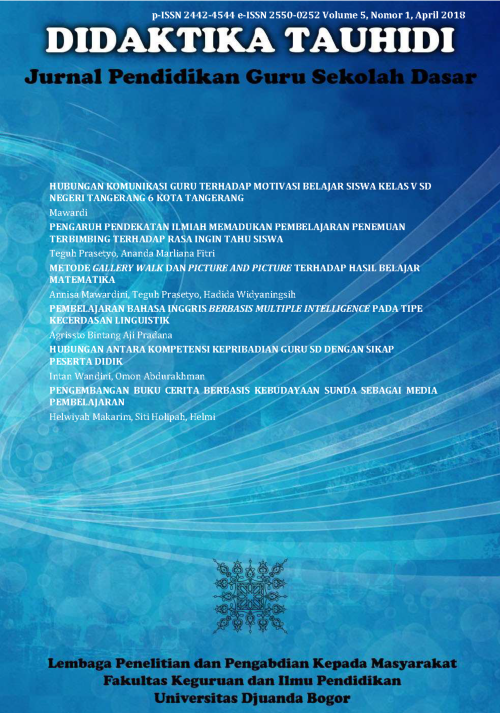GALLERY WALK’S AND PICTURE AND PICTURE TOWARD THE MATH’S RESULT STUDY
Main Article Content
Abstract
This research based on the fact that how low Math’s result study is. That is why the researcher applied Gallery Walk and Picture and Picture method. The aim of this study is to figure out the influence of Gallery Walk’s method implementation and Picture and Picture toward the Math’s result study. The method used was quasi experiment with the static group pretest-postest design. The population in this research was all the student of fifth grader in Pasirgaok 02 elementary school. This research used nonprobability sampling as the technique of sampling which consisted of the saturated sample from two classes experiment. This research used observation, test and questionnaire as the technique of collecting data. According to the analysis result, the average score of posttest class of experiment 1 was 69,5 and the experiment two was 74,8. The result of One Sample T-test was sig 0.00, thus, it was rejected since 0.00 < 0.05 which means the method of Gallery Walk influenced toward the result study of the student. There was a difference in both method through independent T test, sig (2-tailed) 0,05 which rejected to emphasize the difference. So that, there was an influence of Gallery Walk’s method implementation and Picture and Picture toward the Math’s result studyof the fifth graders of Pasirgaok 02 elementary school.
Keywords : Gallery Walk and Picture and Picture method, Math’s result studyArticle Details
1. PROPOSED POLICY FOR JOURNALS THAT OFFER OPEN ACCESS
Authors who publish with this journal agree to the following terms:
- Authors retain copyright and grant the journal right of first publication with the work simultaneously licensed under a Creative Commons Attribution License that allows others to share the work with an acknowledgement of the work's authorship and initial publication in this journal.
- Authors are able to enter into separate, additional contractual arrangements for the non-exclusive distribution of the journal's published version of the work (e.g., post it to an institutional repository or publish it in a book), with an acknowledgement of its initial publication in this journal.
- Authors are permitted and encouraged to post their work online (e.g., in institutional repositories or on their website) prior to and during the submission process, as it can lead to productive exchanges, as well as earlier and greater citation of published work (See The Effect of Open Access).
2. PROPOSED POLICY FOR JOURNALS THAT OFFER DELAYED OPEN ACCESS
Authors who publish with this journal agree to the following terms:
- Authors retain copyright and grant the journal right of first publication, with the work [SPECIFY PERIOD OF TIME] after publication simultaneously licensed under a Creative Commons Attribution License that allows others to share the work with an acknowledgement of the work's authorship and initial publication in this journal.
- Authors are able to enter into separate, additional contractual arrangements for the non-exclusive distribution of the journal's published version of the work (e.g., post it to an institutional repository or publish it in a book), with an acknowledgement of its initial publication in this journal.
- Authors are permitted and encouraged to post their work online (e.g., in institutional repositories or on their website) prior to and during the submission process, as it can lead to productive exchanges, as well as earlier and greater citation of published work (See The Effect of Open Access).

References
Penelitian. Jakarta: PT. Rineka Cipta.
Fraenkel, J.R., dan Wallen, N.E. 2012. How to
Design and Evaluate Research in
Education. New York: McGraw-Hill
Hamdayama, Jumanta. 2014. Model dan
Metode Pembelajaran Kreatif dan
Berkarakter. Bogor: Ghalia Indonesia.
Juhanda, A. 2014 Pengembangan Asesmen
Portofolio Elektronik (APE) untuk Menilai
Sikap Ilmiah dan Penguasaan Konsep Siswa
SMA pada Laporan Praktikum Pencemaran
Lingkungan. UPI: Tesis
Muljo, R. & Daryanto., 2012.Model
pembelajaran Inovatif. Yogyakarta: Gava
Media.
Nurdin, M. & Hamzah, BU., 2012.Belajar
dengan Pendekatan Pailkem. Jakarta: PT.
Bumi Aksara.
Rusdiana, M & Elis, R., 2015.Evaluasi
Pembelajaran. Bandung: CV Pustaka
Setia.
Silberman, Melvin, L., 2005. Active Learning
101 Strategi Pembelajaran
Aktif.Yogyakart: YAPPENDIS.
Sugiyono. 2015. Metode Penelitian
Pendidikan. Bandung: Alfabeta.
Susanto, Ahmad. 2014. Teori Belajar &
Pembelajaran di Sekolah Dasar. Jakarta:
Kencana Prenadamedia Group.

